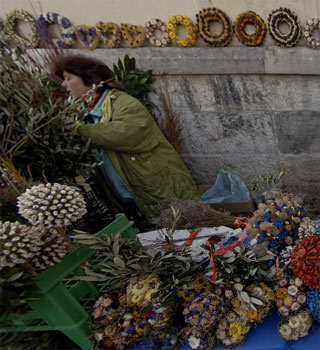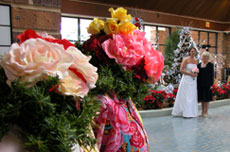Human Flower Project
Saturday, March 31, 2007
Butara for Palm Sunday
In Slovenia, evergreens are bundled with ribbon for Palm Sunday, a radiant beginning for Holy Week.
 Butara for sale
Butara for sale
Pogacarjev Square
Ljubljana, Slovenia
March 2005
Photo: Boštjan Burger
You won’t find many palm trees growing in Ljubljana or anywhere nearby. So much the better. Palm Sunday, remembering Jesus’ final entry into Jerusalem, is observed in Slovenia with a glorious custom, the yearly making and purchasing of butara (literally “bundles”). In these traditional ornaments, sprigs and branches of local greenery are bound up with colored ribbons. Some look to be the size of maracas, others tall as totem poles.
An enduring decorating tradition in Slovenia, the butara are turned out both by schoolchildren and by the pros, who sell their Holy Week wares in souvenir shops, groceries and open-air markets. According to this source, the butara “will often be blessed on Palm Sunday and then placed in the home for the holiday.” We understand that each butara stays displayed in the home all year long; the next spring, it’s discarded and a new one takes its place.
If you check out only one Human Flower Project link all year, be patient as it loads, and let it be this one! Boštjan Burger has composed a series of “Virtual Reality Panoramas” of Slovenia, complete with sound. Three of them show the flower market in Ljubljana’s Pogacarjev Square outside St. Nicolas Cathedral before Palm Sunday 2005. Here, with shuffling feet and clanging church bells, you can see people shopping for butara. There are also beautiful sweeping shots of the flower sellers, with their bouquets of roses and chrysanthemums and fine array of wreaths.
 The Flower Market of Pogacarjev Square
The Flower Market of Pogacarjev Square
March 21, 2005
Ljubljana, Slovenia
Photo: Boštjan Burger
Boštjan writes that some butara are tied together not with ribbon but “shavings of wood …painted various colors.” He calls this custom a “peculiarity of Ljubljana ethnology. Colorific bundles made by handy craftswomen or men are small works of art and the most (re)quested goods on a marketplace in a week before the Palm Sunday. Bundles made from shavings of wood were meant for the townspeople, who had no fields and no cattle.”
Thank you, Boštjan, for permitting us to “snap” a few stills of your magnificent moving pictures. Oh, to be in Ljubljana today!




